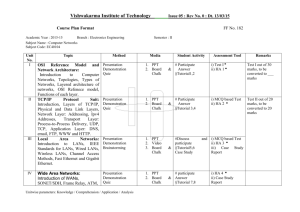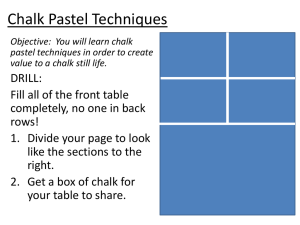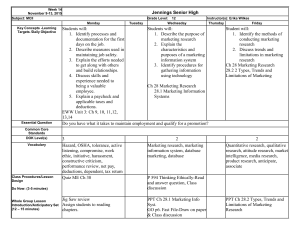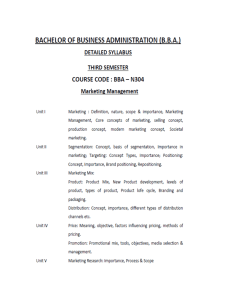File - MOHAN VEERASAMY
advertisement
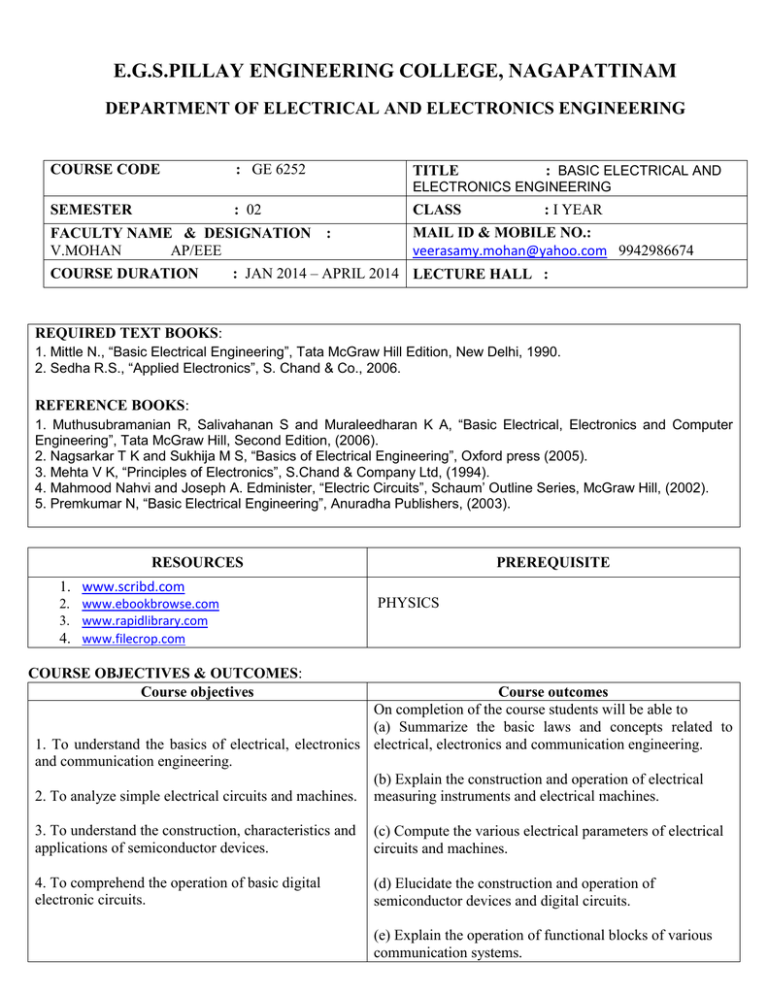
E.G.S.PILLAY ENGINEERING COLLEGE, NAGAPATTINAM DEPARTMENT OF ELECTRICAL AND ELECTRONICS ENGINEERING COURSE CODE : GE 6252 TITLE : BASIC ELECTRICAL AND ELECTRONICS ENGINEERING SEMESTER : 02 FACULTY NAME & DESIGNATION V.MOHAN AP/EEE COURSE DURATION CLASS : : I YEAR MAIL ID & MOBILE NO.: veerasamy.mohan@yahoo.com 9942986674 : JAN 2014 – APRIL 2014 LECTURE HALL : REQUIRED TEXT BOOKS: 1. Mittle N., “Basic Electrical Engineering”, Tata McGraw Hill Edition, New Delhi, 1990. 2. Sedha R.S., “Applied Electronics”, S. Chand & Co., 2006. REFERENCE BOOKS: 1. Muthusubramanian R, Salivahanan S and Muraleedharan K A, “Basic Electrical, Electronics and Computer Engineering”, Tata McGraw Hill, Second Edition, (2006). 2. Nagsarkar T K and Sukhija M S, “Basics of Electrical Engineering”, Oxford press (2005). 3. Mehta V K, “Principles of Electronics”, S.Chand & Company Ltd, (1994). 4. Mahmood Nahvi and Joseph A. Edminister, “Electric Circuits”, Schaum’ Outline Series, McGraw Hill, (2002). 5. Premkumar N, “Basic Electrical Engineering”, Anuradha Publishers, (2003). RESOURCES PREREQUISITE 1. www.scribd.com 2. www.ebookbrowse.com 3. www.rapidlibrary.com 4. www.filecrop.com PHYSICS COURSE OBJECTIVES & OUTCOMES: Course objectives Course outcomes On completion of the course students will be able to (a) Summarize the basic laws and concepts related to 1. To understand the basics of electrical, electronics electrical, electronics and communication engineering. and communication engineering. (b) Explain the construction and operation of electrical 2. To analyze simple electrical circuits and machines. measuring instruments and electrical machines. 3. To understand the construction, characteristics and applications of semiconductor devices. (c) Compute the various electrical parameters of electrical circuits and machines. 4. To comprehend the operation of basic digital electronic circuits. (d) Elucidate the construction and operation of semiconductor devices and digital circuits. (e) Explain the operation of functional blocks of various communication systems. DETAILED LESSON PLAN: UNIT I ELECTRICAL CIRCUITS & MEASURMENTS Ohm’s Law – Kirchhoff’s Laws – Steady State Solution of DC Circuits – Introduction to AC Circuits –Waveforms and RMS Value – Power and Power factor – Single Phase and Three Phase Balanced Circuits. Operating Principles of Moving Coil and Moving Iron Instruments (Ammeters and Voltmeters), Dynamometer type Watt meters and Energy meters. Sess ion No. Topics to be covered 1. Discussion of course objectives and outcomes, basic electrical quantities, circuit elements & sources 2. Text book Instruction delivery Page No Testing method Instructio nal Objective Instructi onal outcome Method Level 1.2 – 1.8 Board & chalk Knowledge OHT 1 a Ohms law, resistors in series and parallel connection, problems 1.9 – 1.16 Board & chalk Analysis OHT THT 1&2 a&c 3. Kirchhoff’s Laws, problems 1-32 – 1.42 Board & chalk Analysis OHT T1 1&2 a&c 4. Source transformation and mesh analysis, problems 1.43 – 1.55 Board & chalk Analysis T1 1&2 a&c 5. Nodal analysis, problems 1.61 – 1.71 Board & chalk Analysis MT 1&2 a&c 6. Fundamentals of AC 2.1 – 2.9 Board &chalk Understanding OHT 1 a 7. Problems in average and RMS values 2.9 -2.19 Board & chalk Analysis THT 2 a&c R5 8. Single phase AC circuits 2.22 – 2.42 Board & chalk Understanding OHT T1 1 a 9. Power in AC circuit and problems in AC circuits 2.22 – 2.42 Board & chalk Analysis T1 OHT 1&2 a&c 10. Three phase circuits and problems 2.46 – 2.54 Board & chalk Analysis OHT T1 2 a&c 11. Measuring instruments – types, analog instruments, operating & control torques. 3.1 – 3.12 PPT Understanding THT 1 b 12. PMMC meters 3.12 – 3.14 PPT Understanding T1 1 b 13. MI instruments ( attraction and repulsion type) 3.15 -3.20 PPT Understanding OHT T1 1 b 14. Dynamometer type wattmeter and induction type energy meter 3.21 – 3.26 PPT Understanding MT T1 1 b UNIT II ELECTRICAL MECHANICS Construction, Principle of Operation, Basic Equations and Applications of DC Generators, DC Motors, Single Phase Transformer, single phase induction Motor. Sess ion No. Topics to be covered 15. Construction, Principle of Operation of DC Generators 16. Text book Page No Instruction delivery Testing method Instructio nal Objective Instructi onal outcome Method Level 4.1 – 4.13 PPT understanding OHT T1 1 a&b Types of DC generators – Circuits, Basic Equations and Applications 4.13 –4.25 PPT understanding OHT 1 a&b 17. Problems in DC generators 4.13 – 4.26 Board & chalk Analysis T1 OHT 2 c 18. Construction, Principle of Operation of DC Motors 4.27 – 4.30 PPT understanding MT T1 1 a&b 19. Types of DC motors – Circuits, Basic Equations and Applications 4.30 – 4.48 PPT understanding MT OHT 1 a&b 20. Problems in DC motors 4.30 – 4.48 Board & chalk Analysis 2 c 21. Construction, Principle of Operation of Single Phase Transformer 4.48 – 4.50 PPT understanding 1 a&b 22. Basic Equations and Applications of Single Phase Transformer 4.54– 4.70 PPT understanding T2 OHT 1 a&b 23. Problems in Single Phase Transformer 4.54– 4.70 Board & chalk Analysis T2 2 c 24. Construction, Principle of Operation of single phase induction Motor 4.70 – 4.71 PPT understanding MT 1 a&b 25. Operation, characteristics and applications of different types of single phase induction Motor 4.71 – 4.81 PPT understanding MT T2 1 b R5 MT OHT T2 UNIT III SEMICONDUCTOR DEVICES AND APPLICATIONS Characteristics of PN Junction Diode – Zener Effect – Zener Diode and its Characteristics – Halfwave and Full wave Rectifiers – Voltage Regulation. Bipolar Junction Transistor – CB, CE, CC Configurations and Characteristics – Elementary Treatment of Small Signal Amplifier. Sessi on No. Topics to be covered Text book Chapter No. and Page No Method Level Instruction delivery Testing method Instructio nal Objective Instructi onal outcome 26. Semiconductors - Introduction 5.1 – 5.10 PPT Understanding OHT 1 a 27. PN Junction Diode – construction, Characteristics and applications 5.13 – 5.21 PPT Understanding T2 OHT THT 1&3 a&d 28. Avalanche and Zener breakdown. Zener Junction Diode – construction, Characteristics and applications Understanding THT OHT T2 MT 1&3 a&d 29. Rectifiers - Half wave and Full wave Rectifiers 1&3 a&d 30. Voltage Regulators – types, zener regulator 1&3 a&d 31. 5.23 – 5.24 PPT T2 MT 5.24 – 5.34 PPT Understanding 5.38 – 5.40 PPT Understanding Bipolar Junction Transistor – construction and operation of PNP & NPN transistors and configurations 5.41 – 5.46 PPT Understanding T2 OHT 1&3 a&d 32. Bipolar Junction Transistor – CB configuration 5.47 – 5.50 PPT Understanding T2 3 d 33. Bipolar Junction Transistor – CE & CC Configurations 5.50 – 5.54 PPT Understanding T2 OHT 3 d 34. Elementary Treatment of Small Signal Amplifier 5.54 – 5.57 PPT Understanding OHT 1&3 a&d R5 T2 OHT UNIT IV DIGITAL ELECTRONICS Binary Number System – Logic Gates – Boolean Algebra – Half and Full Adders – Flip-Flops –Registers and Counters – A/D and D/A Conversion (single concepts) Sess ion No. Topics to be covered Text book Chapter No. and Page No Instruction delivery Method Level Testing method Instructio nal Objective Instructi onal outcome Number Systems and conversions 6.1 – 6.13 Board & chalk understanding THT 1 a Binary numbers- compliments, addition, subtraction Logic Gates 6.13 – 6.21 Board & chalk understanding THT MT 1 a 37 Boolean Algebra and simplification of Boolean expressions. 6.22 – 6.25 Board & chalk understanding MT THT 1 a 38 Half and Full Adders 6.26 – 6.28 Board & chalk understanding THT MT 1&4 a&d 39 Flip-Flops – RS, clocked RS and D Flip Flops 6.29 – 6.32 Board & chalk understanding ORAL 1&4 a&d 40 Flip-Flops – JK, JKMS and T Flip Flops 6.33 – 6.37 Board & Chalk understanding ORAL 1&4 a&d 41 Counters- types, asynchronous counters: up, down and decade counters 6.38 – 6.43 Board & chalk understanding THT MT 1&4 a&d 42 Synchronous counters: up, down, decade counters Ring counters: 6.38 – 6.43 6.47 Board & chalk understanding MT 1&4 a&d 43 Shift Registers 6.51 – 6.53 Board & chalk understanding ORAL 1&4 a&d 44 ADC – SAR and Ramp types 6.53 – 6.56 Board & chalk understanding THT 1&4 a&d 45 DAC – Weighted Resistor and R- 2R types 6.56 – 6.59 Board & chalk understanding MT 1&4 a&d 35 36 R5 UNIT V FUNDAMENTALS OF COMMUNICATION ENGINEERING Types of Signals: Analog and Digital Signals – Modulation and Demodulation: Principles of Amplitude and Frequency Modulations. Communication Systems: Radio, TV, Fax, Microwave, Satellite and Optical Fiber (Block Diagram Approach only). Sess ion No. Topics to be covered Text book Instruction delivery Page No 46. Basic communication system. Types of Signals Modulation and Demodulation Types of modulation 7.1 – 7.5 47. Principles of Amplitude Modulation 7.6 – 7.8 48. Principles of Frequency Modulation 7.8 – 7.11 49. Radio Communication 50. R5 Testing method Instructio nal Objective Instructi onal outcome Method Level Board & chalk understanding MT THT 1 a understanding MT THT 1 a understanding THT 1 a Board & chalk Board & chalk 7.15 – 7.24 PPT Understanding ORAL 1 e TV : Transmitter and receiver 7.25 – 7.34 PPT Understanding MT 1 e 51. Fax 7.34 – 7.36 PPT understanding THT 1 e 52. Microwave Communication 7.36 – 7.41 PPT understanding MT THT 1 e 53. Satellite Communication 7.41 – 7.48 PPT understanding MT 1 e 54. Fiber Optics Communication 7.49 – 7.55 PPT understanding MT 1 e PREPARED BY REVIEWED BY
